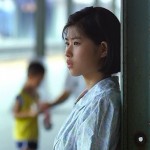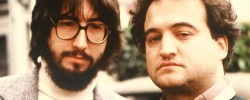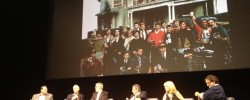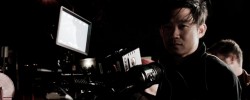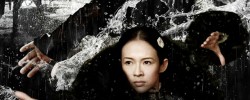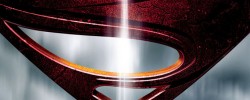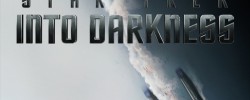TIFF’s A Century of Chinese Cinema: In Conversation With Johnnie To

Editor’s Notes: The following review is part of our coverage for TIFF’s A Century of Chinese Cinema which runs from June 5th to August 11th at TIFF Bell Lightbox. For more information of this unprecedented film series visit http://tiff.net/century and follow TIFF on Twitter at @TIFF_NET.
I haven’t been a reviewer for long however, I have been an avid movie watcher and film student for what seems like forever. For some, film watching becomes an absolute love where you time your week around your favorite movie theatre schedule. Like a writer, a filmgoer becomes seasoned and at a good film, becomes transformed somewhat by the experience. Thinking on it, it was a treat to be sitting in the audience for the In Conversation With Johnnie To.
Mr. To walked into the film stage looking fresh and relaxed. At fifty eight years old, he seemed quite at home in a crisp white shirt and ash black tailored suit. He sat down with Noah Cowan, Artistic Director at TIFF Lightbox to chat about film and his directing career.
Cowan started the conversation by asking how To came to find his individual style:
Johnnie To: “At the time I was simply looking for a job to pay the mortgage and so that I can raise my family. The more I like movies, the more I like the film industry….I think I’m very lucky because up to this day I am still fascinated by movies.
Many of the young directors today have opportunities. They can go to film schools to learn how to be directors and learn how to make movies. As a director, sometimes you have an instinct on how to make a film, but many times we don’t know why we do what we are doing. I remember that at one film festival in Europe, some people told me my film was film noir and I had no idea what that was….It took me a long time to figure out that that was something I was doing, filming a film noir with a film noir style.
Many people say that there is a similarity in my movies with Jean-Pierre Melville. I’d ask them who that was. I was told that he made many movies with Alain Delon. I’ve seen many movies with Alain Delon, but I don’t know if Melville was the director of those films.
It was a fluke how I started making movies. Everything I did was through attempting things and figuring it out through trial and error. Now, so many years have passed that people have commented on my movies. I’ve learned so many things that I didn’t know before. But I’m still testing it out and trying it all out on my own.
Movies like Sparrow, Life Without Principal, and The Mission, are movies I’ve enjoyed making, but they had no script. It wasn’t until I wrapped them up in my head that I came up with a script.
I’m sure professors in films schools will give their students a hard time because the first thing you need to make a movie is a script. That’s why sometimes I feel bad and a little bit embarrassed because I’m against film professor’s ideas.
Anyway, I want more people to make movies. Just follow your mind and don’t worry about the rules.”
Cowan then introduced a scene from Johnnie To’s All About Ah-Long: a little boy goes to meet his mother at a hotel restaurant and looks around at the immensity of the hotel lobby. The camera pulls back to view the boy’s surroundings and then back down at him from the top of the escalator.

Johnnie To: “We had no crane for that shot, so I just shot it from the elevator.
I don’t remember much about that exact scene, but I’m going to tell you a little bit about this movie. The last scene has Chow Yun Fat raising the bike and falling. And it is the most important stunt and most important shot of the film. I did a bit of research and watched a documentary where a bike is rolling over and I talked to the stunt driver and said, “I want this shot.”
Then he said, “Let’s practice.”
The night before we shot it, I had dinner with my wife in Macau and the stunt driver said, “Ok we can do the shot. But if I succeed, I will break my two thumbs. If I fail, I will break my neck. So are we going to do it?“
I said yes. I made sure we had an ambulance waiting for him on the set though. I was so scared.
I didn’t even look at the camera while the stunt was going on. There was so much action with the bike rolling over and then suddenly it was all quiet. Everybody ran toward the bike. I waited for my assistant to call me on the walkie-talkie. It was only ten or twenty seconds, but to me it felt like a year of waiting. And then finally I get the call and the assistant tells me the stunt driver was ok and was on his feet.
Later on that day at dinnertime, the stunt man came to visit me. He asked if we got a good shot. Then I looked at him and both of his thumbs were in casts. It was unforgettable.”
To is a very animated when talking about his films. You can tell that not only is he interested in making film, he’s more interested with making film with constraints, which in some ways leads to his signature style.
Johnnie To: “It was ‘98 or ‘99 that I made The Mission. Hong Kong had the financial recession after 1997, at that time nobody wanted to touch movies and I didn’t want to go back to television. And I remember I had a friend in Taiwan. I talked to him and he gave me 2.5 million to make the movie. The money that I got from him wasn’t enough to make the film, but I set out to make it anyway. I had forty thousand feet of film to make it. I knew it was going to be a low budget movie. So I had to find good actors that could do shots in one take to keep it on budget.
I shot the movie in nineteen days with only one take allowed for each shot. Lam Suet was working on props and wasn’t an actor, but his look was what I wanted for my film. And he was low budget! I had limited resources to make this film. It was going to be a gunshot movie, but we were going to be very few gun shots. I made the movie at a slow tempo and it was under ninety minutes, with a low budget and no script. But I made it!
So it was a total surprise to me that The Mission became so successful. But it came from natural instinct because I had little resources and just used whatever I had. That’s why I can’t answer to my style. I just use what I have.”
Cowan asked him about his cat and mouse theme in Running Out of Time which is repeated theme in a lot of his films since then.
Johnnie To: It was a challenge for me to make Running Out of Time. I asked Andy Lau to make the character less Andy Lau and he said ok. He said whatever you say I will do. Both me and Andy were testing waters though because there was no script. I remember that there were more than 30 takes for each shot. Then he wondered if acting was for him. It was more of a cat and mouse game between me and Andy. It was almost like a reflection of the relationship our relationship and it subconsciously came out in the film.
Sean Lau is very important in Running Out of Time too. We were thinking about the film while we were shooting it. Sean is a very calm actor and he gave me a lot of suggestions for it. It was Andy, Sean, and I. If we failed we’d fail together.
I think I like a challenge. Under the circumstances, any mistakes and planning are stimulating to me.”
To was asked about the regular ensemble of actors in this films. Cowan explained that it is very uncommon for modern day actors to use the same actors.
Johnnie To: “I’m very lucky. The movie PTU I shot it over two years. No one knows, even the cast doesn’t know when it will finish. Sparrow took me over three years to shoot. Life Without Principal started in 2009 and finished in 2011. I think I’m bold because who knows if the actor is still alive for us to finish the movie. I don’t think about it.
The reason I use the same actors is because they trust me. During the film process I believe they also enjoy it. Other than the trust between me and the cast, the other reason is that I’m kind of a lazy person. I don’t want to spend too much time trying to find people who don’t understand me. Also, my favorite film director is Kurosawa. He does the same by using the same cast. I am still learning from him.”
It is rare to see such a prolific director with years of experience under his belt, claiming that they are still learning. I’m so used to hearing directors claim that the film industry is a certain way or that things need to be done according to the known plans. My suspicions are that this how To continues to make ground breaking films.
A clip from the famous seven minute tracking shot from Breaking News was shown and Cowan asked To how he planned that shot. Was there a storyboard? How much planning and rehearsal time was allotted to making this memorable shot?
Johnnie To: “I never thought that I was making an adventurous shot. The first thing I had to do was find a street with no people there. I think after this movie the street was going to be demolished, so we were allowed to film there. The challenge to me first was find the props for this empty street to make it feel like it was habited. It was tough. We rehearsed it for three days. A real crane was very expensive, so we built a wooden crane first. On the third day a real crane was brought to the set, so we used it instead of the wooden one. We had a whole crew just to make sure the crane cable didn’t get caught with the equipment. What you saw in the clip, there were actually more than ten people making sure that cable didn’t get caught or get shot in the scene. I remember at one point the crane was turned at 360 degrees. Since it’s electronic equipment, I was afraid that it would break down. What would we do then?
It is common in Hong Kong movies that to use whatever we have to get things done. I didn’t use a storyboard for this scene or for any of the movie. I just knew that I wanted one shot, the one with the newspaper flying onto the windshield of the car. I used the street wire above for that. There was one person working on it, but it was stubborn and it took seven to eight times to get it right. I got anxious every time. It was an expensive magazine too. If it didn’t work, I’d have to replace it. It was a lot of pressure. Then there were four minutes after that shot to film the most important part: the gunfire. What I remember when we finally got the newspaper shot that we had to get the rest of it right because we only had one take!
I was very moved by all the crew in this film. After seven times of trying and failing, the focus to get it right united us. Making sure the guns were working fine and that the dolly was operational.
It’s almost like a dream being realized making that shot happen. I didn’t think about the people that had to suffer to make that shot happen. When I finally said cut they all applauded.”
After the talk was over, Johnnie To asked, with a genuine honest smile to boot, if he could come back and talk at TIFF after the release of his next film. Honestly, I really hope he is asked to come back. I didn’t realize how much I loved film until he reiterated that he was still learning how to get film right. I’m still learning how to do this right and I think the best I can do to learn that is by going with my gut and progressing as I go along the way.
Thank you, Mr. To.
Related Posts
Jacqueline Valencia
Latest posts by Jacqueline Valencia (see all)
- Review: Lovelace (2013) - August 14, 2013
- Review: The Canyons (2013) - August 9, 2013
- Review: Killing Season (2013) - July 29, 2013




